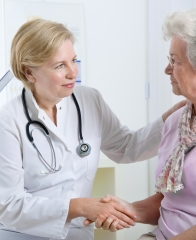 / The Vagina Dialogues
Subscribe
/ The Vagina Dialogues
Subscribe

Although most of us always suspected that we were never really alone, few of us feel crowded in our own body. Yet, since the time of our birth we have lived with trillions of bacterial cells on and in our body, known as our microbiome. Despite the unflattering reputation that microorganisms hold, most of these bacterial cells are beneficial to our health, and some of them are crucial to it. But how does it all start? It turns out that the most likely source of your first microbiome was your mother’s vagina. Or skin if you were born by cesarean section. Either way, you can thank your mother for not only giving birth to you but also for your microbiome. The vaginal microbes of your mother were most likely ingested and inhaled by you during delivery, making their way to your gastrointestinal tract where they became your first intestinal microbiome or your first probiotic exposure (live microorganisms). If you were breastfed, those microbes also received the nutrients to sustain their growth, or your first prebiotics (microbe food), as well as immune factors that aid with a healthy development and mutually beneficial life long relationship between your microbiome and your immune system.
What if none of this happened to you and instead you were born prematurely, by cesarean section, and not breastfed? Should you not thank your mother then? No, you will most likely be fine and you should always thank your mother. There are some studies showing that you can distinguish the microbiome of babies born through cesarean section and vaginal delivery up to 2 years of age. At that point that difference fades away, most likely as the result of the transition to adult-like diets. Some studies do indicate that your risk of developing food and respiratory allergies correlate to some extent with the mode of delivery and whether you were breastfed or not, so what happens during those 2 years is likely relevant to your health. But, both your microbiome and your immune system grow and learn with you. So, your level of exposure to friendly microbes is just as important as avoiding the unfriendly ones. Diversify your diet, and go outside and get dirty!
But what about your vagina? Well, all vaginas are different, just like every hormonal and menstrual cycle is different between women, but your environmental exposures have a determinant impact. As Wellesley College helped establish, women who co-habit sync their menstrual cycles with each other, which most likely is related to the hormonal and/or pheromonal cross-exposure. But what about the vaginal microbiome and why should you care? The seeding of the vaginal microbiome has not been determined but it is thought to derive from the stool microbiome, think about babies and diapers. And while there are differences between individuals and among some ethnic groups, most human vaginal microbiomes are dominated by Lactobacilli, a friendly (beneficial) species of bacteria. These types of microbes like to feed on glycogen, which is a sugar produced by cells in the uterine and vaginal walls, especially when stimulated by estrogens (the hormones that peak during ovulation). In return the Lactobacilli produce lactic acid, keeping the vaginal environment with an acidic pH, an environment that most other bacteria avoid. The dominance of Lactobacilli species and the maintenance of a vaginal acidic pH seem to be strong indicators of gynecologic health, in particular during pregnancy. During the first trimester of pregnancy, the dominance of Lactobacilli achieves a complete or almost complete takeover of the vaginal environment in healthy pregnancies. It is thought that this takeover is due to the high levels of estrogens, which stimulate production and storage of glycogen, and progesterone, which stimulates glycogen break down, experienced during pregnancy. The lack of a Lactobacilli dominated community during pregnancy is correlated with preterm birth and higher risk of bacterial, viral, and fungal infections. In fact, not having a Lactobacilli dominated community before pregnancy is correlated with infertility, preterm delivery, miscarriage, and risk of various infections.
What we are also finding is that as you get older and reach the menopause years, the microbiome takes center stage again. Menopause is a time of tremendous hormonal changes and Lactobacilli are heavily impacted in this process. The ovarian shutdown of estrogen production has as much impact on the host as it does on the microbiome. For reasons we do not yet understand, some women are able to hold on to their Lactobacilli while others are not. Those who are not, have an increased risk of infection by opportunistic bystanders. These bystanders are microbes like Atopobium, Peptoniphilus, Porphyromonas and other dubious characters. They may have been peaceful bystanders or simply passing by. But, just like toddlers in the absence of supervision and left with scattered candy bars, they can do a lot of damage. We are now finding that these particular microbes are associated with endometrial cancer and are working towards determining what their exact role in the disease is. We also have data suggesting that the vaginal microbiome may be a relevant factor in the determination of response to ovarian cancer treatment and maybe even in the disease itself. So, thank your mother and her vaginal microbiome, and take care of yours.
Afterword
by Marc Tetel
With so many questions left to answer about the vaginal microbiome, my lab is collaborating with Marina Walther-Antonio (Mayo Clinic), Nicholas Chia (Mayo Clinic) and Christen Deveney (Psychology, Wellesley College) to study how diet, exercise, and mood can affect the vaginal microbiome. To this end, we have enlisted the help of some outstanding Wellesley students who have volunteered to let us investigate their microbes and their fluctuations throughout daily life. We expect to recover precious information about what a mutually beneficial vagina microbiome relationship looks like, and perhaps learn what makes helpful microbes leave and allow bad ones take over. In addition, we hope this study will enable us to use these microbes as biomarkers of trouble yet to come (such as endometrial and ovarian cancers), and allow us to identify and treat individuals at risk before a potentially bad outcome.





